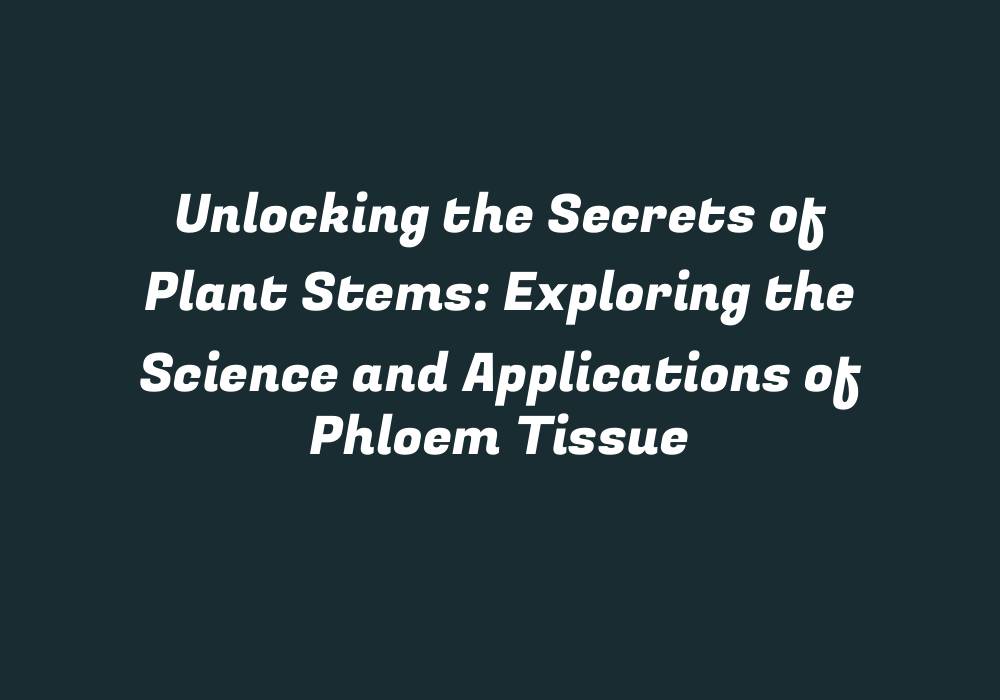Introduction to Phloem Tissue in Plant Stems
Plants are remarkable living organisms that have evolved to adapt and thrive in a variety of environments. Their ability to produce food through photosynthesis, along with their capacity for growth and reproduction, is possible due to complex interconnected systems within the plant body. These systems work together, allowing plants to survive and flourish even under challenging conditions.
One such system crucial to understanding is the phloem tissue, which plays a vital role in sustaining the entirety of the plant organism. This article aims to delve deeper into the science and applications of phloem tissue within plant stems.
The Structure and Function of Phloem Tissue
Phloem is one of two vascular tissues in plants, and it makes up a major part of the vascular system responsible for nutrient distribution throughout the plant. The other vascular tissue is xylem, which is primarily concerned with water and mineral transport. Phloem is made up of living cells that facilitate the movement of food materials from leaf cells to reproductive organs or developing parts of a plant.
The primary function of phloem tissue in plants includes:
1. Transportation of Food: After photosynthesis, sugars and other nutrients produced by chloroplasts in the leaves are transported down through the stem to different parts of the plant via the phloem tissue. This ensures that all essential resources are distributed uniformly throughout the plant, allowing it to grow and reproduce effectively.
2. Translocation of Starch: In some species of plants, such as bamboo, the storage form of carbohydrates in the leaves is starch. When these plants need energy for growth or reproduction, phloem tissue facilitates the transportation of starch from leaf cells to other areas where it can be broken down and used as a source of glucose.
3. Signal Transfer: Phloem tissue also plays a role in intercellular communication and hormone signaling within plants. It is believed that this function enables plants to adjust their physiological responses according to changing environmental conditions.
Applications of Phloem Tissue
1. Genetic Engineering: The phloem tissue can be utilized in genetic engineering as a means for transporting DNA molecules or other biological agents throughout the plant body. By manipulating the genetic makeup of plants at various growth stages, researchers can alter their traits to improve crop yield, increase disease resistance, and develop novel food products.
2. Plant Growth and Development: Understanding the role and functioning of phloem tissue has allowed scientists to enhance plant growth and development through targeted interventions. By optimizing nutrient distribution within plants, researchers can create healthier, more robust plants that are better equipped to survive in various environmental conditions.
3. Bioremediation: Phloem tissue can be used for bioremediation purposes, where plants are engineered to remove harmful substances from the environment. For instance, phloem-based systems have been developed to remove heavy metals and pollutants from contaminated soil and water sources, contributing to a cleaner and healthier environment.
4. Medicine and Pharmaceuticals: The unique structure of plant stems has made them an essential component in traditional medicinal practices for centuries. Understanding the role and functioning of phloem tissue within these stems can help researchers develop new therapeutic agents and enhance the effectiveness of existing treatments.
5. Food Production: By harnessing the power of phloem-mediated transportation, researchers can develop more efficient and productive agricultural practices that can contribute to food security worldwide. For instance, optimizing nutrient distribution within plants can improve crop yield while maintaining their overall health.
In conclusion, the science behind phloem tissue in plant stems offers a wealth of opportunities for advancing various fields such as agriculture, medicine, and environmental management. By exploring its structure, function, and potential applications, researchers can unlock numerous secrets that will lead to positive impacts on our world and beyond.
